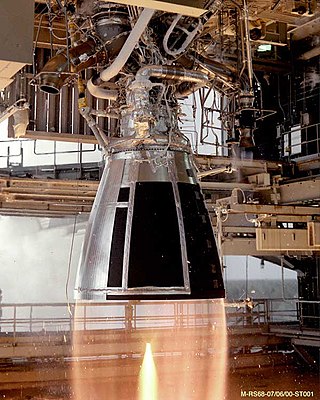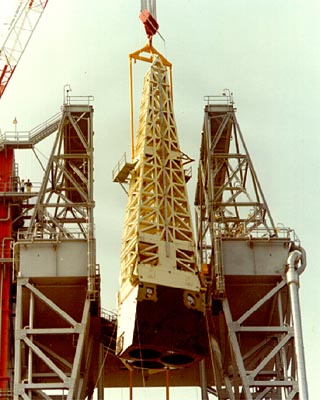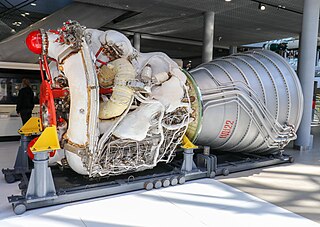Space Shuttle Main Engine is a rocket engine used by NASA.
SSME may also refer to:
- Service science, management and engineering
- Society for the Study of Medical Ethics, successor of the London Medical Group
- Sri Lanka School of Military Engineering
Space Shuttle Main Engine is a rocket engine used by NASA.
SSME may also refer to:
SME may refer to:
EE, Ee or ee may refer to:
Me most often refers to:
An officer is a person who has a position of authority in a hierarchical organization. The term derives from Old French oficier "officer, official", from Medieval Latin officiarius "an officer," from Latin officium "a service, a duty" the late Latin from officiarius, meaning "official."
Ime is a village in Norway.
Ned or NED may refer to:

The Space Shuttle Solid Rocket Booster (SRB) was the first solid-propellant rocket to be used for primary propulsion on a vehicle used for human spaceflight. A pair of these provided 85% of the Space Shuttle's thrust at liftoff and for the first two minutes of ascent. After burnout, they were jettisoned and parachuted into the Atlantic Ocean where they were recovered, examined, refurbished, and reused.

STS-104 was a Space Shuttle mission to the International Space Station (ISS) flown by Space Shuttle Atlantis. Its primary objectives were to install the Quest Joint Airlock and help perform maintenance on the International Space Station. It launched on 12 July 2001 at 09:04 UTC, and returned to Earth without incident after successful docking, equipment installation, and three spacewalks.

The Aerojet Rocketdyne RS-25, also known as the Space Shuttle Main Engine (SSME), is a liquid-fuel cryogenic rocket engine that was used on NASA's Space Shuttle and is currently used on the Space Launch System (SLS).
EPR may refer to:

The Aerojet Rocketdyne RS-68 is a liquid-fuel rocket engine that uses liquid hydrogen (LH2) and liquid oxygen (LOX) as propellants in a gas-generator power cycle. It is the largest hydrogen-fueled rocket engine ever flown.
MSE may refer to:
TEC may refer to:

The Main Propulsion Test Article (MPTA-098) was built by Rockwell International as a testbed for the definitive propulsion and fuel delivery systems for the U.S. Space Shuttle Program.
Build may refer to:
IBE or Ibe may refer to:

Space Shuttle abort modes were procedures by which the nominal launch of the NASA Space Shuttle could be terminated. A pad abort occurred after ignition of the shuttle's main engines but prior to liftoff. An abort during ascent that would result in the orbiter returning to a runway or to an orbit lower than planned was called an "intact abort", while an abort in which the orbiter would be unable to reach a runway, or any abort involving the failure of more than one main engine, was called a "contingency abort". Crew bailout was still possible in some situations in which the orbiter could not land on a runway.
Service science, management, and engineering (SSME) is a term introduced by IBM to describe an interdisciplinary approach to the study and innovation of service systems. More precisely, SSME has been defined as the application of science, management, and engineering disciplines to tasks that one organization beneficially performs for and with another. SSME is also a proposed academic discipline and research area that would complement – rather than replace – the many disciplines that contribute to knowledge about service. The interdisciplinary nature of the field calls for a curriculum and competencies to advance the development and contribution of the field of SSME.

The Soviet RD-0120 (also designated 11D122) was the Energia core rocket engine, fueled by LH2/LOX, roughly equivalent to the Space Shuttle Main Engine (SSME). These were attached to the Energia core rather than the orbiter, so were not recoverable after a flight, but created a more modular design (the Energia core could be used for a variety of missions besides launching the shuttle). The RD-0120 and the SSME have both similarities and differences. The RD-0120 achieved a slightly higher specific impulse and combustion chamber pressure with reduced complexity and cost (but it was single-use), as compared to the SSME. It uses a fuel-rich staged combustion cycle and a single shaft to drive both the fuel and oxidizer turbopumps. Some of the Russian design features, such as the simpler and cheaper channel wall nozzles, were evaluated by Rocketdyne for possible upgrades to the SSME. It achieved combustion stability without the acoustic resonance chambers that the SSME required.

The Shuttle-Derived Heavy Lift Launch Vehicle ("HLV") was an alternate super heavy-lift launch vehicle proposal for the NASA Constellation program. It was first presented to the Augustine Commission on 17 June 2009.